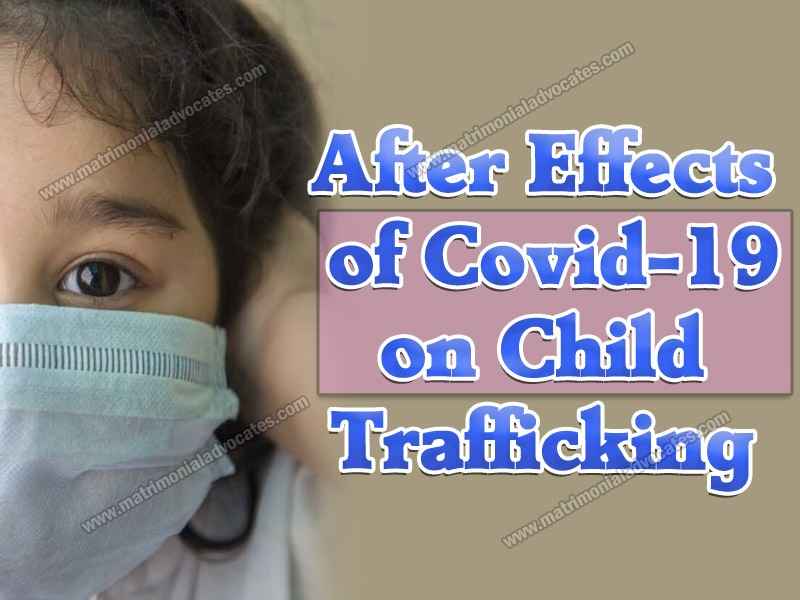
When the world is fighting with the pandemic situation and every inch of thought in minds of our efficient government is in regard to protect it from spreading in whole world. Indian Government has explicitly succeeded in controlling the cases of Covid-19. But somewhere in between of all this pandemonium our government has lost the touch or it will be appropriate to say that they are pre occupied with the pandemic issue that they can’t really focus on other major issues which are occurring in our society.
During the lockdown we were concerned with the present issues of covid-19, which was mostly highlighted by media through varieties news channel, but none really calculated the aftermath of covid-19. Once the lockdown will be lifted two scenario will be likely to emerge: Firstly, employers will resort to extreme measures to get their businesses back running and afloat, even at the risk of violating the law, by employing child labour which is cheaper than other labour; Secondly, employing and exploiting bonded labour in lieu of debts given especially during the lockdown, longer working hours than are permitted under law, longer working days, lower wages, etc.
The immediate impact of the Indian government’s decision to ‘lockdown’ the entire country was collective panic, followed by the collective loss of jobs of hundreds and thousands of migrants labourers originally hailing from Bihar and UP, two heavily populated northern Indian states that ‘supply’ a bulk of the labour to India’s megacities. This created a state of havoc in society, especially among labour class and class below the poverty line, who also works as daily wagers because they have suffered not only economic loss but much more than that.
Where we were all settled in our homes with all comforts, this specific class was suffering the most. Government at their best provided all assistance and basic necessity to people who were in need. But this was just during lockdown but what about after lockdown is lifted and covid-19 vanishes in thin air, more relentless problems will occur in front of government.
The COVID-19 crisis will have a potentially far-reaching, long-term negative impact on children around the world. Widespread job and income loss and economic insecurity among families are likely to increase rates of child labor, sexual exploitation, teenage pregnancy, and child marriage. Stresses on families, particularly those living under quarantines and lockdowns, are increasing the incidence of domestic violence.
As the global death toll from COVID-19 has been increasing day by day, consequently large numbers of children will be orphaned and vulnerable to exploitation and abuse. Also, the huge number of unorganised and migrant workers on the fringes or outside the socio-economic security umbrella, are the most vulnerable. This makes them the easiest target for the organised crime network of human trafficking.
COVID-19 LOCKDOWN EFFECT ON CHILD TRAFFCIKING
As above we already shared a concerned that once lockdown is lifted and normal manufacturing activity resumes, factory owners will look to cover their financial losses by employing cheap labour. Increasingly, desperate and vulnerable populations of unorganised workers, who are in no position to negotiate wages or their rights, will be a massive pool for cheap labour. A large number of these labourers will be children who are forced out of school and bearing the burden of sustaining their families. Thousands of children will likely be trafficked across the country to work in manufacturing units where they will be paid meager to no wages and will most likely face extreme physical, mental and sexual violence.
Along with the health crisis, and the economic and labour market shock that the pandemic has generated, the vulnerability of millions to child labour is another issue that merits serious attention. The children of farmers and agricultural labourers in India are at even greater risk. As government restrictions to movement and gatherings have been imposed during harvesting and marketing time, in the absence of helping hands, children will be the fallback option to assist parents in the fields.
Before the lockdown, a bench of the Delhi High Court Chief Justice was closely monitoring a PIL by Bachpan Bachao Andolan (BBA)on rescue and rehabilitation of child labour in Delhi, and an entire structure of coordination between different departments was worked out to effectively implement the Delhi Action Plan for Total Abolition of Child Labour. However, now as the situation has become graver, the response to it must be stronger.
Children currently are exposed to domestic abuse and being exploited in many states but further far worse scenario will take place after the lockdown is lifted. The situation will also be alarming for legally working children thus, for many children, the COVID-19 crisis will mean limited or no education, or falling further behind their peers. This will induce a large number of children to discontinue their study even after “normalcy” is restored. There is a high probability of many of these out of school children getting involved in child labour.
The forces behind the business of pushing children into commercial sexual exploitation have faced ‘financial loss’ as a consequence of the lockdown will seek to overcome this loss through high-return investments, i.e. a girl from a family which has lost its means of subsistence and survival.
Even the pornhub, the largest pornography platform in the world, has seen a 20-time jump in India, from 0.9% on February 24 to 18.1% as on March 16. A large segment of this ‘content’ includes trafficked children who are exploited to create pornographic material. Adults and children who consume this content are likely to ‘normalise and fetishise’ child rape and sexual violence, which may translate into offline sexual violence.
Experts estimate that the global total of COVID-19 deaths could eventually reach 10 to 40 million, which will inevitably leave many children without one or both parents or other caregivers. Orphaned children are particularly vulnerable to trafficking and other exploitation, including sexual exploitation, forced begging, selling goods on the streets, and other child labor. Older children often drop out of school to try to support younger siblings.
The child trafficking and child labour is not a new term which people have came across. This is the outcome of non-employment and development in our society, for decade several NGO with collaboration with government have been fighting against it and until now gave some better results in protecting these children from such abuse. Due to this sudden hazard has affected the lives of major population but on same hand it has also rapidly elevated crimes against children.
Where Human Rights Watch urges governments to take urgent measures to protect children’s rights, including by:
- Prioritizing efforts to continue education for all children, using all available technology;
- Providing economic assistance, including cash transfers, to low-income families that will be hit first and hardest, to help them meet basic needs without resorting to child labor or child marriage;
- Minimizing disruptions in children’s access to essential and life-saving healthcare services;
- Increasing efforts to identify children orphaned by COVID-19 and expanding networks of extended family and foster care.
- Expanding public education, awareness campaigns, hotlines, and other services for children at risk of violence in the home or online sexual exploitation;
- Transferring children deprived of liberty to family-based care and ensuring suitable accommodation and sanitation for refugee, migrant, and internally displaced children.
A rights-respecting response to the COVID-19 crisis will not only alleviate potentially far-reaching harm during the pandemic, but can also benefit children over the long term, Human Rights Watch said. Expanding internet access for children will generally increase children’s access to information, and their ability to organize and express themselves.
The Ministry of Human Resource Development (MHRD) has suggested that all schools should connect with their students through digital platforms to compensate for the loss of school hours. Our government is lacking in taking other measures for protecting the vulnerable children who are suffering during the pandemic and going to even suffer severely after the lockdown is hoisted.
COUNTER ON CHILD TRAFFICKING AND LABOUR
As the central and state governments struggle to contain the immediate health and economic challenges, a great amount of planning must go into dealing with the imminent impact of this crisis, especially in terms of the safety of the most vulnerable children.
1. Assessment and review of legal framework: The central government must assess the existing criminal law on trafficking and its ability to counter the crime and meet the needs of the victim. The lapsed anti-trafficking bill needs to be amended and passed in Parliament urgently.
2. Inspections of factories and manufacturing units: Small and medium business will try and operate through unregulated manufacturing units to subvert inspection and must be contained within the system of accountability.
3. Increase in budgetary allocation for law enforcement and victim rehabilitation: There is a gross deficit in the budgetary allocation to combat bonded labour and trafficking. Up to 2016, 3.13 lakh bonded labourers have been rescued. The rehabilitation framework for rescued bonded labourers was strengthened in 2016, though, a central government scheme provides for compensation up to Rs 3 lakh to victims.
From the date of the notification of this scheme till December 2019, Bachpan Bachao Andolan, founded by Nobel Peace Laureate Kailash Satyarthi, has rescued 1,550 child bonded labourers and 2,823 child victims of trafficking. The rehabilitation of these children alone required a minimum of Rs 100.2 crore. Yet, the total allocation for the scheme in the national budget is only Rs 100 crore annually. This calls for an immediate hike, especially focused on the rehabilitation of rescued bonded labourers and trafficking victims.
The impending humanitarian crisis in the aftermath of the ongoing global health crisis is real. Our foresight and preparedness in the midst of the current lockdown can save the lives many children and build a strong economic foundation of the economy. The value of human life and the collective effort to protect it goes beyond this temporary period of the lockdown.
CONCLUSION
As the threat of widespread death looms over India, and knowing full well the weaknesses and incompetencies of government agencies in dealing with massive medical emergencies, community-based care and support programmes for vulnerable and orphaned children should be a critical component of post-Covid-19.
The governments could also liberally and deeply involve NGOs who have specific specialties in dealing with crises involving children in both urban and rural communities. The after-effects of a pandemic can be devastating, not only in terms of death and attendant destruction but also in terms of the insecurities that can potentially be unleashed on children- health, malnutrition, abuses of all forms, sexual violence, trafficking, diseases, PTSD, each of which need and require specific responses and interventions.
The Child Labour (Prohibition and Regulation) Amendment Act, 2016, which prohibits the engagement of adolescent children in hazardous occupations and processes, slashed the list occupations considered hazardous from 83 to 3 (mining, explosives, and occupations mentioned in the Factory Act). However, data shows children between 15-18 years engaged in hazardous work account for 62.8% of the India’s child labour workforce, 10% of whom are engaged in family enterprises. Because of low production during COVID-19, recently, many of the state governments are in the process of extending working hours at factories from a maximum of 8 hours to 12 hours a day with a limited workforce. Such a provision, seen in the context of adolescent child workers, will mean more at lower wages, as children are the cheapest labour force.
Overall, we are observing such abuse on vulnerable children originating from COVID-19 that are creating profound consequences for the anti-trafficking field. To better the gauge the needs of survivors and the anti-trafficking community in this time of crisis, and to enable the continued sharing of developments within the field to volunteer more in this cause and try to help as much as we can to protect these children from such abuse.
Child trafficking is a national, international crime. As per my opinion we can make a positive difference in the lives of victims of child trafficking and also to prevent up to an extent this kind of horrendous crime. We are at home in lockdown mostly people working from home some not. We can take this as an opportunity to educate children in our neighborhood whose parents may be cannot afford education. We can educate them not only subjects we study in school but also some realistic education so that they can protect themselves from traffickers. Many children are been forced to labor because of their peers but some are there who go by choice to protect their families.
We as citizen of this country can be aware and when next time we see any child on road side doing some dancing and tricks or begging or see any child working as labour in restaurants or small thelis (shops) we can call on child line number 1098. This small step can prevent children from being exploited by their traffickers.




